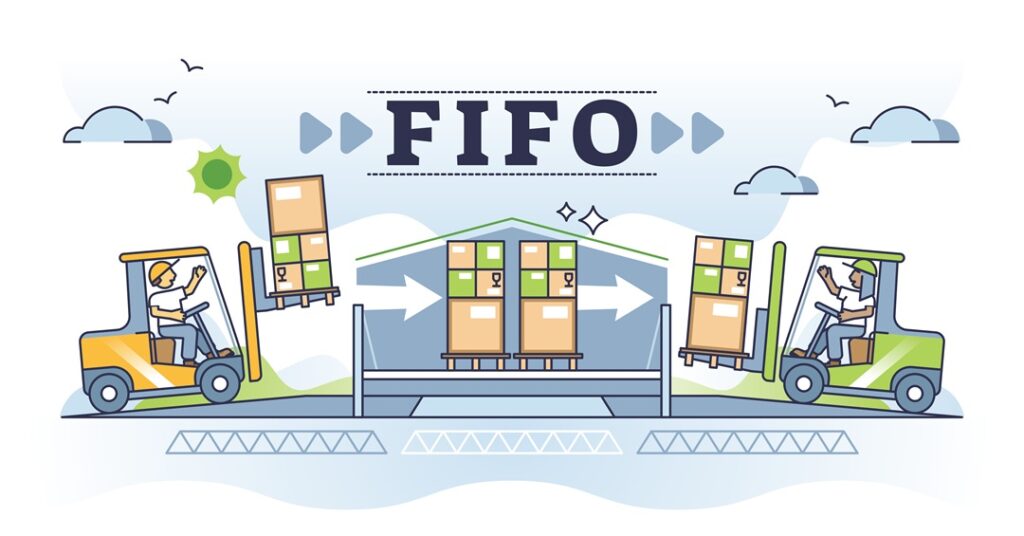
It is used to fulfil specific needs in different industries. In particular, FIFO management plays a vital role in the following industries:
Food Industry: The deterioration and freshness of food products is one of the most critical areas. The first products entering the warehouses reach the consumer first, thus minimising the risk of spoilage.
Pharmaceutical and Chemical Industries: In these sectors, expiry dates and quality control of products are of great importance. It is an ideal method for shelf life control of products.
Retail: In fashion and other fast-moving consumer goods, prolonged stock-outs can lead to obsolescence or changes in consumer preferences. This helps to maintain product turnover.
Manufacturing: Inventory management of raw materials and parts used in production is organised with FIFO in order not to disrupt the production process.
It ensures the orderly management of products within the warehouse, thus minimising the possibility of spoilage and obsolescence of old products.
It is used to fulfil specific needs in different industries. In particular, FIFO management plays a vital role in the following industries:
Food Industry: The deterioration and freshness of food products is one of the most critical areas. The first products entering the warehouses reach the consumer first, thus minimising the risk of spoilage.
Pharmaceutical and Chemical Industries: In these sectors, expiry dates and quality control of products are of great importance. It is an ideal method for shelf life control of products.
Retail: In fashion and other fast-moving consumer goods, prolonged stock-outs can lead to obsolescence or changes in consumer preferences. This helps to maintain product turnover.
Manufacturing: Inventory management of raw materials and parts used in production is organised with FIFO in order not to disrupt the production process.
It ensures the orderly management of products within the warehouse, thus minimising the possibility of spoilage and obsolescence of old products.
Warehouse management systems and automation technologies play a major role in increasing the efficiency of the application. In addition to traditional methods, warehouse management can be further optimised thanks to today's digitalised warehouse management. Here are some of these technologies:

The transition to automation systems may initially require high investment costs. However, in the long term, these costs are offset by increased productivity and reduced wastage rates. It is important for businesses to evaluate technological investments with return analyses.
Warehouse space may need to be organised to support FIFO. An incorrectly designed warehouse can lead to products not being placed in the correct order and disruptions in the check-out process. Support from expert consultants in warehouse design and the use of modern warehouse planning methods play a critical role in solving this problem.
FIFO is an important strategy in warehouse management that prioritises the removal of the oldest products, thus increasing product freshness and efficiency. Many sectors such as food, pharmaceuticals, chemicals, retail and manufacturing optimise inventory turnover and achieve transparency in cost management thanks to FIFO. With the support of technological developments, the application area of the FIFO method is expanding day by day and is supported by modern warehouse management systems.
Determining the right strategies in inventory management is one of the main factors that increase the competitiveness of enterprises and support sustainable growth. The FIFO method enables businesses to manage their stocks accurately and efficiently, providing flexibility against economic fluctuations. Therefore, with the right warehouse design, integration of automated systems and expert consultancy services, FIFO is a candidate to be an indispensable tool in the logistics management of the future.
If you decide to implement the FIFO principle in your business, it will be useful to review your existing warehouse layout and technological infrastructure and support your inventory control processes with innovative solutions that digitalise your inventory control processes. Thus, your warehouse management will become both more economical and more transparent.
These advantages provide significant contributions not only in cost control and tax calculations, but also in terms of customer satisfaction, product quality and environmental sustainability of the business. Steps to increase productivity, optimise business processes and minimise inventory errors are the key to success in a competitive environment.
Continuous development and innovation in warehouse management ensures that your business is one step ahead of the competition. Modern systems working with the FIFO principle offer strategic advantages to your business with instant tracking of data and accurate analyses. It should not be forgotten that technological investments will provide a return in the long term and offer significant savings in warehouse management costs.
While FIFO offers a more organised, transparent and cost-effective solution compared to traditional warehouse management methods, it is a critical element that will positively affect all operations of your business when applied correctly.